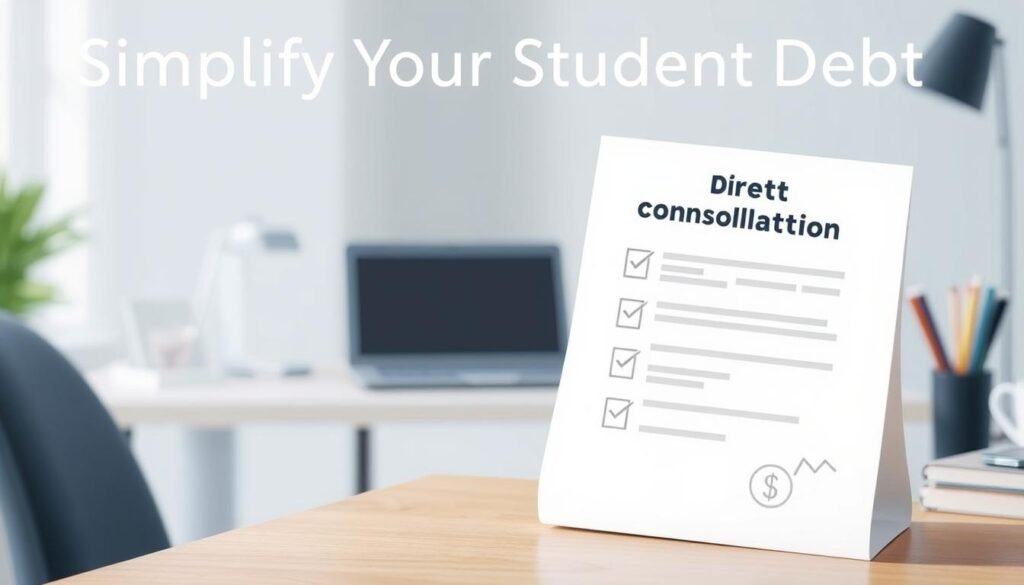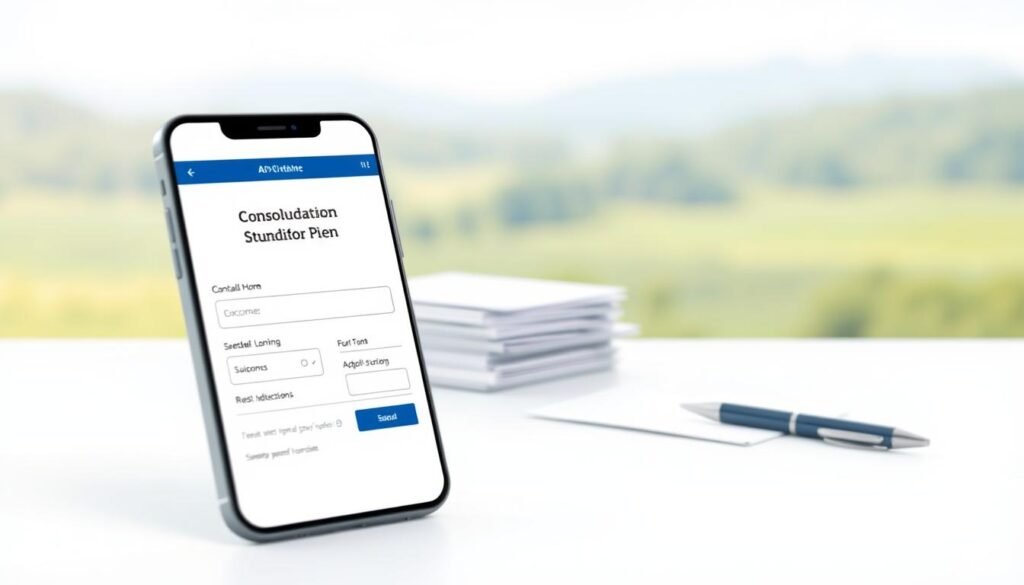
Simplify Your Student Debt: USA Loan Consolidation Application

Have you ever wondered if one simple step could make repayment easier and unlock public service options?
This guide shows where to start, what to include, and how to protect benefits you value.
You’ll learn how to create a new direct consolidation loan online through StudentAid.gov or by mail. Include only the loans you want in a single consolidation loan so you keep other protections intact.
The right plan can lower monthly bills. If you pick an income-driven choice, submit the IDR form with your consolidation application to avoid delays. After you apply, review the summary the Department sends quickly so errors don’t become final.
Repayment usually begins within 60 days after disbursement, but you can request temporary forbearance if an initial interest payment feels tight. If you aim for public service or loan forgiveness, your account may move to MOHELA.
Why and When to Consolidate Your Federal Student Loans
If you juggle different servicers or have older FFEL or Perkins accounts, consolidation may help.
The two biggest reasons people choose consolidation are clear: convert FFEL or Perkins balances into a Direct Consolidation Loan so those balances count toward forgiveness paths like PSLF, and simplify payments by moving multiple servicers into one account.
Sign in to StudentAid.gov to view your listing and spot which accounts are labeled Direct, FFEL, or Perkins. That view helps you decide which accounts you want to include and which to leave out.
- Include or exclude: You can add Parent PLUS loans or keep them separate based on your repayment plan goals.
- Timing matters: If any account is in a grace period, you can ask for delayed processing so repayment doesn’t start early.
- Exit default: Consolidation can be used to get out of default, but it requires extra steps to restore good standing.

Weigh the trade-offs. Combining accounts can simplify tracking and position older balances for loan forgiveness. But mixing different interest rates can reduce flexibility later. Review your listing carefully before you commit.
What You Need Before You Apply: Documents, Decisions, and Servicer Choices
Get organized now so your consolidation application moves quickly and without surprises.
First, sign in to StudentAid.gov and review your listing in NSLDS. Confirm each account type Direct, FFEL, or Perkins and note your current servicer details so your application matches official records.
Check your listing and pick loans to include
Make a clear list of the loans you want consolidate and those you’ll keep separate, such as parent plus loans you may treat differently.
Choose a repayment plan and add an IDR request if needed
Compare options and select a repayment plan that fits your budget. If you want income-driven payments, submit the repayment plan request (IDR) with your consolidation to avoid delays.
Select a servicer and decide paper vs. online
Pick a loan servicer with your goals in mind. Note that PSLF-eligible consolidations are assigned to MOHELA.
If NSLDS misses accounts, use the Direct Consolidation Loan Application and Promissory Note and attach the Additional Loan Listing Sheet to list any missing loans.

| Item | Why it matters | Action |
|---|---|---|
| NSLDS listing | Shows types and balances | Verify before you start |
| Loans to include | Affects forgiveness and payment | List loans want consolidate |
| Repayment plan choice | Determines monthly amount | Submit plan request or IDR with application |
| Servicer selection | Sets who manages your account | Choose or accept MOHELA for PSLF |
Step-by-Step: student loan consolidation application process USA
Begin by assembling your records and choosing whether to file online or by mail for a smoother consolidation.

Start the Federal Direct Consolidation forms online
Complete the Federal Direct Consolidation Loan Application and Promissory Note at StudentAid.gov. The system runs an NSLDS lookup and fills a listing of federal loans so you can confirm each account quickly.
Verify and adjust the NSLDS listing
Check the listing loans the system shows. Add missing accounts or remove loans you don’t want consolidate before you submit.
Pick your repayment plan and submit the plan request
Choose a repayment plan and attach a repayment plan request or an IDR form if you want income-driven terms. Including the plan request with your submission speeds approval.
If you file on paper: forms and aidvantagepo box addresses
Paper filers should include these forms: Direct Consolidation Loan Application and Promissory Note, Additional Loan Listing Sheet, Request to Add Loans, Repayment Plan Request, or Income-Driven Repayment Plan Request.
- Nelnet - PO Box 82658, Lincoln, NE 68501-2658, 866-426-6765
- Edfinancial (C/O Aidvantage) - PO Box 300008, Greenville, TX 75403-3008, 800-722-1300
- MOHELA (C/O Aidvantage) - PO Box 300006, Greenville, TX 75403-3006, 800-722-1300
- Aidvantage - Attn: ED Loan Consolidation, PO Box 300005, Greenville, TX 75403-3005, 800-722-1300
What your servicer does next
Your chosen servicer issues a Verification Certificate, confirms the payoff amount with current holders, and pays off the underlying balances.
After payoff posts, the servicer begins servicing your new direct consolidation loan and reports the change to NSLDS. Look for the "Paid In Full Through Consolidation" status and verify the payoff amount matches the confirmation.
Grace handling and special cases
If an underlying account is in a grace period, you may request delayed processing so repayment does not begin too early.
You can also consolidate a single FFEL, Perkins, or Parent PLUS account to qualify for PSLF or to exit default. The servicer will resolve any overpayments or underpayments and set up your new direct servicing account within expected days.
Next Steps and Support: From Processing to First Payment
Next steps are straightforward. After your submission, the Department sends a summary that confirms which loans are included and the repayment plan you chose. Review that summary quickly and contact them if anything is incorrect.
If the new servicer asks for initial interest before your official payment is set, request a short forbearance so you are not strained while the payment is calculated. Repayment on a direct consolidation loan typically begins within 60 days after disbursement.
Watch for messages from your assigned loan servicer it may differ from the one you picked. If you run into issues, call the Federal Student Aid Information Center at 1-800-433-3243. If PSLF is your goal, confirm assignment to MOHELA and keep employment certification up to date.
Keep a simple checklist of confirmation numbers, dates, and servicer notes. Review parent plus details carefully so plan choices stay flexible. For related guidance and context, see this piece on credit scores and next steps.
If you want to know other articles similar to Simplify Your Student Debt: USA Loan Consolidation Application you can visit the category Consolidation.




Leave a Reply